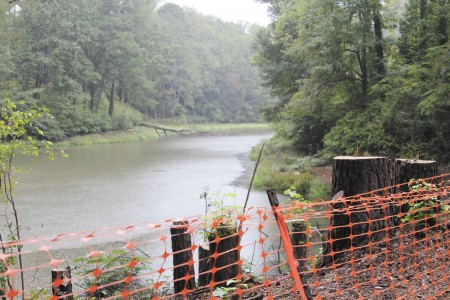The goal of the state Safe Dams Program is as simple as its name suggests. But when the program identifies dams—including two in Sandy Springs—as needing safety-related repairs, the process can get complicated quickly and can take years.
The local Lake Forrest and Tera Lake dams are in conditions that concern the state, but are still ongoing issues more than seven years after the first notices were sent to dam owners, said Tom Woosley, program manager of the Safe Dams Program. In part, that’s due to issues in identifying and getting cooperation from dam owners; it’s also due to the state’s lengthy review processes.
Tera Lake, off Burdette Road, is an example of a “long enforcement process that can go on for years,” said Woosley. And, he said, the dam under the 4600 block of Lake Forrest Drive is “definitely not going like the typical project. It’s taken so much longer.”
Lake Forrest and Tera Lake are two of 11 dams in the Brookhaven, Buckhead, Dunwoody and Sandy Springs area on the state’s list of “high-hazard” dams. That means that if the dams failed, the flood likely would kill people.
The high-hazard classification is not a judgment about the current condition of the dam. But it does trigger regular state inspections and suggests the stakes involved if a safety problem is discovered.
The dam on Tera Lake (also known as Berezney and Lee Lake on some maps), built in 1958, is one such situation. The state placed the dam on the high-hazard list in early 2008 and has had serious concerns about its condition. In 2013, Woosley said, inspectors found “an instability with slope of the dam” and ordered its partial drainage. The dam remains a safety concern because heavy rains could build up the water again. “It would not take much at all for the lake to fill back up again,” he said.
But the Safe Dams program had trouble identifying the dam’s owners from the start. In 2008, the state sent dam-operating permit forms to four potential owners, only one of whom responded—with the form declaring the dam’s owner “unknown.”
Since then, Woosley said, two owners have been involved in coordinating repairs and maintenance, particularly Marc Pollack. Pollack is the chairman and CEO of the Pollack Shores real estate firm, but the company is not a dam owner, Woosley said. Pollack did not respond to interview requests.
The Safe Dams program is scheduled to inspect the dam early next year for the first time since 2013, though the owners have privately-hired engineers examining it as well. The state believes work still needs to be done to stabilize the Tera Lake dam.
“It does need upgrading,” Woosley said. “Here we are today and nothing is submitted to us for getting it into compliance. This office is going to have to push them to get moving on it.”
Lake Forrest dam also ran into long ownership confusion when Safe Dams declared it high-hazard in 2009. It is partly owned by the homeowners around the so-called Three Lakes the dam creates, but it also runs under a road on the Atlanta-Sandy Springs border. The two cities have agreed to do repairs and split the costs.
Trees will have to be removed from the dam, Woosley said. And the cities are in the process of assessing the condition of an internal pipe, which requires draining the lake. A partial draining—including the removal of fish—was carried out several months ago. But it took until Nov. 30 to get state permission to fully drain the lake, said Sandy Springs City Attorney Wendell Willard, who is supervising the work.
“Anytime you touch the structure itself, you need approval of the state,” Willard said. The work so far has cost $98,000, he said.
Editor’s note: This is one of a series of articles Reporter Newspapers is publishing about dams in our communities. Previous installments have looked at the locations and conditions of the 11 local high-hazard dams, the lack of public information about their potential flood zones, and the costs of maintaining high-hazard dams.

